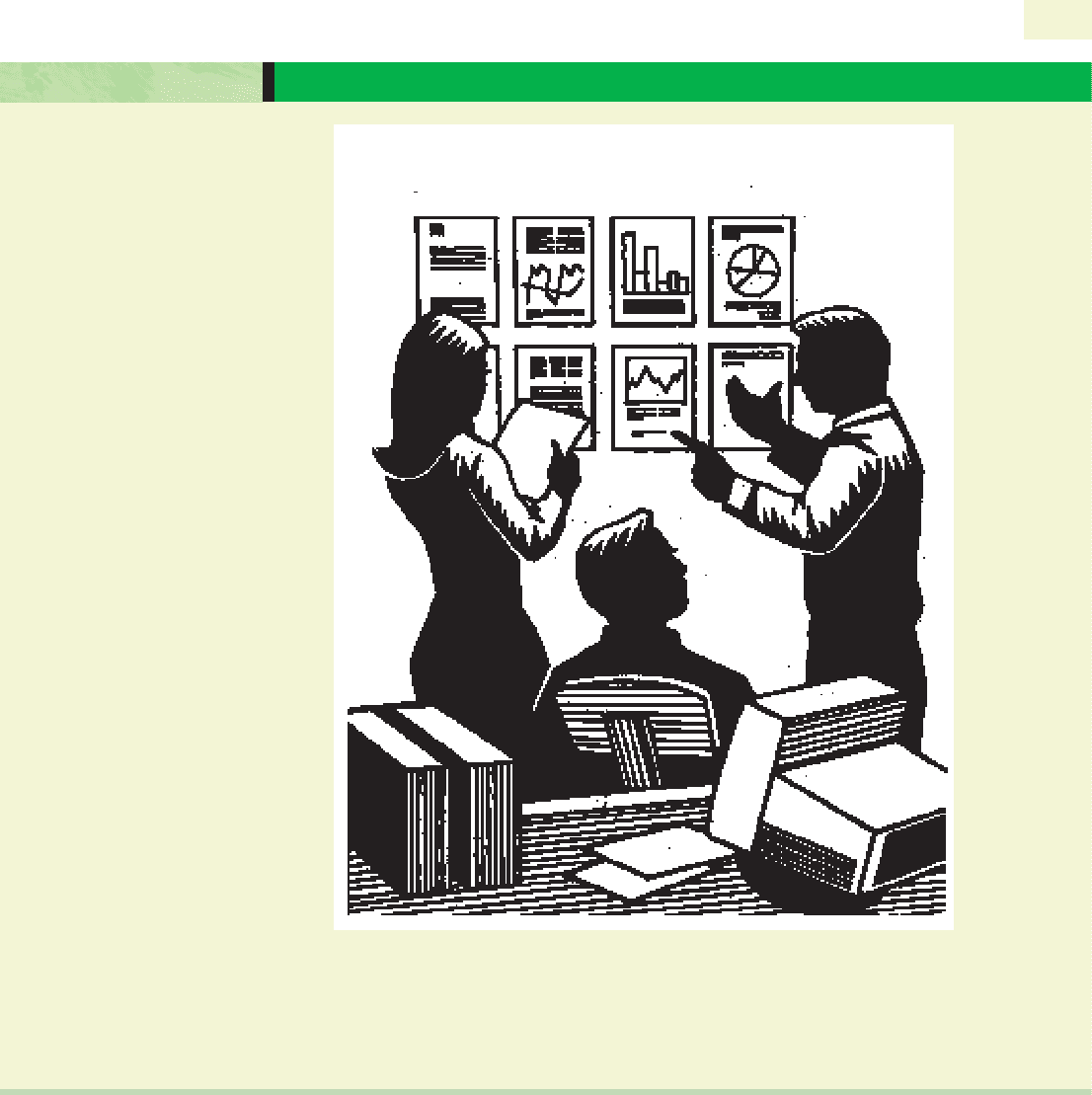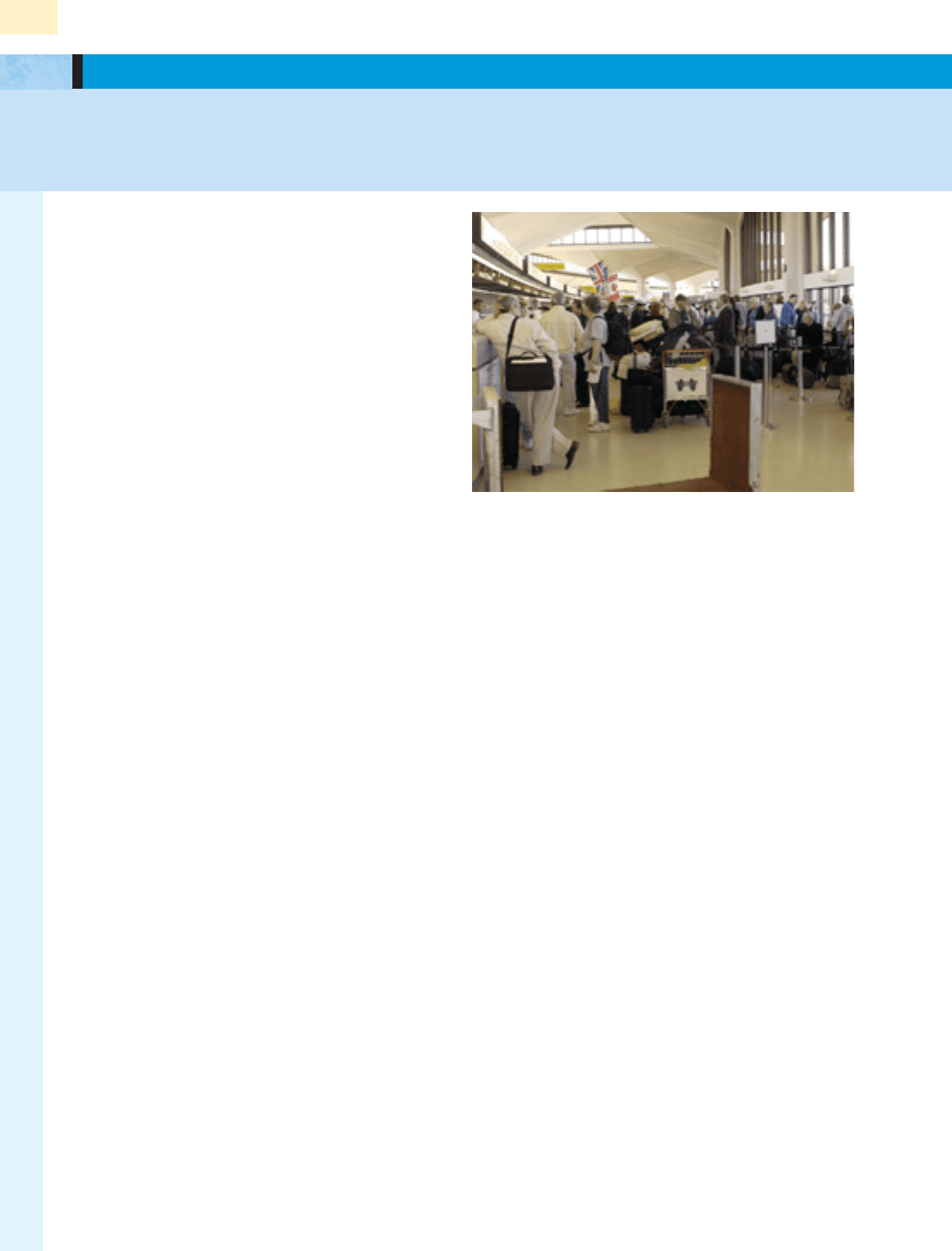Mullins L.J. Management and organisational behaviour, Seventh edition
Подождите немного. Документ загружается.


CHAPTER 12 WORK MOTIVATION AND REWARDS
505
Adverse effects of current reward strategies
This conflicts with current reward strategies in organisations
that seem to support and reinforce hierarchies rather than lat-
eral co-operation. In addition, they tend to reward the job
rather than the individual. Usually, career progression and
bonus payments (for those whose results are not measurable
using hard data) depend on patronage rather than merit and
there is a tendency to reward those who sustain the status
quo rather than those who are innovative and entrepreneurial.
Finally, most reward strategies have unfairness built into
them. For example, it is easier to reward sales staff on their
personal performance than scientists in research laboratories.
The sense of unfairness creeps in if staff who help sales
people design and develop the ‘winning’ solution do not
share in the bonus that accompanies a successful sale.
Managers often sympathise with the scientists but do nothing
to change the system on the grounds that it is ‘too difficult’,
and has historical precedence. The more hard-nosed man-
agers usually suggest that those scientists who want bonuses
should join the salesforce or stop bellyaching about their lot.
This approach just does not make sense in a world hungry for
innovation and the rewards that it brings.
Reward options
Staff and managers should realise that rewards are multi-faceted
and usually come in bundles that combine money, achievement,
personal and professional growth and self-esteem. This means
that the reward options open to management are very varied, as
the examples in Table 12.3 show.
Table 12.3 Reward options for knowledge workers
Financial rewards Non-financial rewards
Salary + bonus based Personal growth
on gain sharing
Knowledge or professional
Salary + profit sharing growth
Employee ownership Status and public or private
recognition
High salary + benefits
Career growth
Salary and bonus on
individual or team effort Job security
What managers should do is create reward bundles (fruit-
bowls of choice) that more closely fit the needs of a group of
employees rather than impose a blanket system on them all.
For example, an individual or group could be offered a bundle
which comprises salary plus profit sharing, status, personal
growth. Another group or individual could be offered a differ-
ent bundle comprising salary plus bonus on personal effort,
career growth and professional growth. The reward bundles,
drawn from a reward portfolio, are probably the fairest way to
reward individual effort and contribution.
Performance measures
Inappropriate performance measures do more harm than
good. In knowledge-based organisations, performance must
be judged primarily by how the individual or group contributes
to the knowledge added value of the organisation. This may
take the form of specific creative outcomes, new knowledge
generated or knowledge disseminated. Meeting targets and
deadlines and solving critical problems, which contribute to
customer added value, should also feature as measures.
Climate for optimising reward strategies proposed
Whatever scheme is used, it is imperative that those subject
to these schemes can earn the promised rewards if they fulfil
their part of the bargain. This means first of all that they can
achieve the task they have been set. Among the necessary
ingredients for this are:
■ role and goal clarity;
■ having the knowledge and skills or having the opportunity
to acquire them;
■ having sufficient autonomy and delegated authority to get
the job done;
■ having a wider understanding of what the organisation or
department is trying to achieve and how the individual’s
work fits in with this;
■ quality standards and defined deliverables;
■ having a good knowledge of what is happening in the
organisation as a whole and the threats and opportunities
that it may experience.
However, where these conditions do not prevail and where
there is strong hierarchical governance, reward strategies are
wasted because the individual’s skills and talents are not
being tapped.
What should organisations do?
■ Define and create a climate for success to match its busi-
ness objectives.
■
Widen opportunities for career growth by adopting multiple
career streams, effective review systems, personal mentoring
and strive to ensure equality of treatment for all employees.
■ Reward managers on their ability to create and sustain the
climate for success.
■ Devise fruit-bowls of reward options.
■ Revise the career expectations of staff so that they value
professional and technical skills development and status
as highly as clambering up the management ladder.
■ Reward the individual rather than the post and reward
each according to his or her contribution.
■ Reward staff for enhancing their own knowledge value, the
collective knowledge of the organisation and contributing
to the organisation’s core competences.
■ Measure corporate climates and fine-tune them.
■ Measure knowledge value added.
■ Measure customer value added.
(Reproduced with permission of Professor Mahen Tampoe.)

PART 4 THE INDIVIDUAL
506
a List, as far as possible in rank order, the specific needs and expectations which are most
important to you as an individual. (Do not include basic physiological needs such as to
satisfy thirst or hunger, or a minimal standard of accommodation.)
b Explain, briefly, to what extent these needs and expectations are met currently from your
present work situation; and/or to what extent you anticipate they will be met from your
future career ambitions.
c Think of any work experience which you have had – even a short-term, vacation or part-
time job. Briefly describe:
(i) those aspects of the job and/or experiences which motivated you to work well; and
(ii) those which had a demotivating influence on your behaviour/actions.
d Be prepared to share your feelings and comments as part of a class discussion.
ASSIGNMENT 1
1 Explain what you understand by the underlying concept of motivation. Summarise the
main needs and expectations to be taken into account in considering the motivation of
people at work.
2 What do you understand by frustration-induced behaviour? Give a practical example,
preferably from your own work experience, of each of the main forms of this behaviour.
3 Why is the study of the different theories of motivation important to the manager?
Distinguish between content and process theories of motivation.
4 Critically assess the practical value of Maslow’s hierarchy of needs model to improving the
motivation of people at work. Give examples of the extent to which the theory could mean-
ingfully be applied to staff in your own organisation.
5 Discuss critically the validity of the contention that the motivation for staff to work well
depends on more than a high salary and good working conditions.
6 Explain your understanding of expectancy-based theories of motivation. Use a simple dia-
gram to help explain an expectancy theory of your choice. What implications do expectancy
theories of motivation have for the manager?
7 Give practical examples of situations in which each of the following theories of motivation
might be appropriate: (i) achievement motivation; (ii) equity theory; (iii) goal theory.
8 Discuss how you believe managers might best develop reward strategies to motivate and
compensate knowledge workers.
9 Explain fully and with supporting reasons which one theory of motivation you believe is
likely to be most appropriate in a particular work situation of your choice.
REVIEW AND DISCUSSION QUESTIONS

CHAPTER 12 WORK MOTIVATION AND REWARDS
a Write a brief description of what you think is happening to the people in the picture and
what you think will happen to them in the future.
b After you have written your description compare your response with those of your
colleagues.
ASSIGNMENT 2
507

508
PART 4 THE INDIVIDUAL
OBJECTIVES
Completing this exercise should help you to enhance the following skills:
Assess the strength of your different motivational needs.
Avoid generalisations about what motivates people.
Take account of individual differences and meet the needs of others.
EXERCISE
You are required to complete the Motivation Grid by taking each factor in order as follows.
1 Compare Salary (A) with Structure (B) – cell 1. Choose which factor you value more in rela-
tion to your work and write the code for that factor in the cell. For example, if you choose a
good salary as being more important to you than structure and guidelines, enter A in the
cell. If you prefer to have well-explained procedures and clarity in your work rather than a
high salary, enter B in the cell (for structure).
2 Move to cell 2 – Salary (A) versus Social contact (C) – and enter your chosen letter code.
Continue along the top line comparing Salary (A) with the other factors and entering the
chosen letter code in each cell. Move to the second line and compare Structure (B) with
each other factor.
3 When you have filled in all 36 cells, add up the number of entries for each letter code and
enter these sub-totals into the score table.
4 If you find it very difficult to choose between two factors, you may put both letters in the
cell – you will then score half a point for each: do not do this too often (it weakens your
responses), say no more than five times.
Motivation Grid
The scores show a mirror reflection of what you felt as you filled in the Grid. These scores
alter over time, as you develop in your career and as your domestic, social and physical
Structure
B
Social
C
Recognition
D
Achievement
E
Influence
F
Change
G
Creativity
H
Interest
I
Salary
A
1 2 3 4 5 6 7 8
9 10 11 12 13 14 15
16 17 18 19 20 21
22 23 24 25 26
27 28 29 30
31 32 33
34 35
36
Structure
Social
Recognition
Achievement
Influence
Change
Creativity
PERSONAL AWARENESS AND SKILLS EXERCISE

CHAPTER 12 WORK MOTIVATION AND REWARDS
509
needs change. The factors that tend to change most over time and circumstances are A, B
and G. High scores for a factor indicate a high level of need, and low scores indicate a low
level of need, relative to other factors.
The norms obtained from 1355 managers and professionals (kept on our database) will be
given to you by your tutor. If you are below the norm, you have a low need for the factor, if
you are above it, you have a high need.
Motivation Grid score sheet
Please fill in the score table below. Add up the number of times you have put A in any cell on
the Grid and enter that total in the column ‘Your score’ against A. Continue for B, C and the
other factors until you have totalled all nine of them. Your tutor will give you the norms later.
DISCUSSION
■ How surprised were you with your ‘score’ and to what extent did it differ from the ‘norm’?
■ What factors should managers bear in mind when designing incentive and reward systems?
■ How important is an understanding of perception for the effective motivation of staff?
■ What conclusions do you draw from this exercise?
Note: Keep a record of your Motivation Scores for a subsequent exercise in Chapter 18.
The full 12-factor Motivation to Work Profile, from which this Grid is extracted, is copyright to and available from Sheila Ritchie of Elm
Training and all international rights are reserved. It was created in 1989, developed and tested (with the help of Peter Martin of Arlington
Associates from 1989–98). Further testing has been done in the UK and internationally, especially for its use as a team working development
tool to date. Copies of the Profile may be obtained by e-mail to sritchie@elm-training.co.uk or by telephone on +44-18487-773254.
Factor Your score Norm
A – Salary
B – Structure
C – Social contact
D – Recognition
E – Achievement
F – Influence
G – Change
H – Creativity
I – Interest
Total = 36
Visit our website www.booksites.net/mullins for further questions, annotated weblinks,
case material and Internet research material.

510
PART 4 THE INDIVIDUAL
CASE STUDY 12.1
Staff motivation: not so much a pyramid, more a slippery
slope
My contact with my direct line manager is limited to
irregular e-mails which are purely directional and/or
informative. At no point is there any attempt to either
help with my staffing problems or to acknowledge that
these may be stress related. It follows then that there is
no form of motivation downwards from him to me,
although it is taken for granted that I will be self-moti-
vated and able to motivate my team.
In the highly competitive world of international air
passenger transport, the bottom line is everything.
As such, all aspects of flight operations are subject to
the rigorous cost–benefit analysis known as revenue
per kilometre flown. This has led to some decisions
which would deeply disturb Joe Public. When he
purchases an airline ticket he is taking part in a lot-
tery – the element of chance being the availability
of the flight, seat class or flight time of his choice.
Joe Public feels that buying his ticket gives him this
automatic right – but he should read the small print.
Price banding restrictions linked to historical
marketing statistics allow airlines to estimate the
number of passengers who will present themselves
for a particular flight as opposed to those who will
choose to exercise their flexibility muscle. For exam-
ple, if 70 per cent of the plane’s capacity is made up
of economy seats, a condition of which is that no
changes are allowed, then it can be reasonably
assumed that this group will travel on the given day
or not at all. Flexibility to price ratio continues up
the scale until the top notch ticket is reached. The
high price tag at this level promises that the airline
will strive to provide the frequent flyer with all that
he requires. Further, statistics indicate that having
made this investment, he will almost certainly
travel since, ceteris paribus, he has chosen to pay an
inflated price to guarantee that he will reach his des-
tination when and how he wishes.
At this stage there remains only one small per-
centage of passenger statistics to be correlated and
here restrictions linked to price again come into
play, limiting the degree of usage of the flexibility
muscle to the minority of passengers travelling
‘open jaw’. These people will have paid a sufficiently
large supplement in order to allow themselves the
luxury of being flexible in their travel arrangements.
As one would expect, this market segment has been
shown to be the most likely not to travel and it is
this information which the airlines use in their cal-
culations. Should, as is likely, a proportion of this
user group decide to change their plans, as is their
right, then the airline would be faced with the eco-
nomic disaster of high revenue seats flying empty
and seriously reducing the company’s desired
margin of revenue. In order to cover this contin-
gency proactively, the company chooses always to
overbook these seats by the calculated percentage of
passengers who will probably choose not to travel.
The above organisational difficulties are not new,
however the systems in which they operate have
changed drastically both in the attitude to accept-
able levels of passenger discomfort and in the
variety and number of duties which staff are now
expected to carry out. As a manager in this environ-
ment Piet Andaro faces many challenges daily, the
most daunting of which is to find a way to motivate
his team who know with absolute certainty that
during every shift they will have irate passengers.
They, the passengers, will see them as the acceptable
outlet for their outrage at what they perceive as
unjust/unfair treatment, not to mention downright
bad service. When the expected treatment fails to
materialise Joe Public is not so much outraged by
the failure of the actual mechanics but that his faith
and trust have been misplaced.
It is then the role of Piet and his team to achieve
the unachievable – to not give the customer what he
wants but to send him on his way feeling that he
has received outstanding service by people who gen-
uinely care about his needs. Most importantly to the
airline, he will take with him such a positive feeling
that he will happily use the airline in the future and
encourage others to do so.
Photo: Nancy Wegard/Getty Images

CHAPTER 12 WORK MOTIVATION AND REWARDS
These problems are not eventualities – most opera-
tors working in such a fast-moving environment are
equipped to deal with most of these – but certainties,
built into the system in order to maximise profit. Part
of this drive towards even greater profits has, as with
many multinationals in the 1990s, resulted in a
restructuring of operations which in real terms has
meant a paring down of the workforce to what senior
management call optimum efficiency. In this case it
also involves a flattening of the management struc-
ture to be a ‘leaner fitter organisation’.
At the most extreme level, management in the
organisation has been subject to great change, some
enforced and some planned. Although the manage-
ment structure is traditional and hierarchical, it is
simultaneously attempting to achieve flatter organisa-
tion status. The motivation system therefore is
roughly as follows:
1 Senior management should motivate themselves.
2 Piet should motivate himself and his team.
3Individual members of the team should motivate
themselves.
4 Sideways motivation is due to the fact that
although each manager has the same title there
are varying grades of responsibility and support
All those with the designation ‘manager’ may have
the same title, but their knowledge, experience and
skills levels vary dramatically. Not only do skills
vary dramatically, so does motivation. To be lacking
in a skill is a solvable problem, given time and the
appropriate training. To be lacking in motivation is
almost incurable, according to Piet. ‘Although some
members of management may not have perfect
knowledge, built into the system is a way of finding
most of what you need to know. However they
would rather pick up the phone and ask me even if
by doing so he is causing an already stressed cus-
tomer to wait while he does so.’
A recent buzzword for organisations has been
‘strategy’ with each aspect of the business having its
own strategy while being interdependent on all the
others. Particularly highlighted and linked have been
the communications minefields of customer service
and human resource management. Practitioners tell
us that the only way for a human resource initiative
to be effective is that it must be integrated and strat-
egic. There are arguments as to whether the human
resource element should be considered first and oper-
ations based around it, or whether the operations
should be put in place and then the appropriate
human resource found. It is generally agreed that all
human resource functions should be integrated to
each other and that ‘best fit’ should be obtained.
Often, though, this is sold to the company at all
levels not as best fit but as best practice; however,
once in place, as in our case study, these systems and
operations are looked on as success panaceas and are
never examined for their functionality. The rationale
is that as they have been designed by experts at great
cost then they should be left alone.
On paper the system should work, with the less
able learning from the proficient, however in the
real world of the service industries, people dealing
with people, management demands consistency.
Failure to provide this results in frustrated staff and
aggrieved passengers, leaving those at the sharp end
to constantly bear the brunt of the results of this
revenue versus service conundrum.
Stress-related illness has been well documented
and Piet is unfortunately acquainted with this
phenomenon, faced as he is with a daily stress-related
absenteeism of around 25 per cent. This non-
existence of one-to-one or even regular verbal contact
is further exacerbated by the fact that although
appraisals are built into the system, in reality they are
never carried out. This means that senior manage-
ment has no feedback on the operational problems
and difficulties which Piet encounters and as there is
no procedure in place they are never communicated.
Also the question is raised of how he will be able to
face the daily aggression and stress without support.
Sometimes I just feel like not going to work but the act of
putting on the uniform brings about a kind of metamor-
phosis – I begin to look forward to the day. Each shift
brings a new set of problems and with it I find new capa-
bilities and competencies within myself. I like to be
proactive wherever possible, for example if I know a flight
is going to be seriously overbooked then myself and my
team will have a contingency plan or plans ready for
when the crisis hits. I think the secret is to treat every
event as completely new; it would be very easy to become
cynical as it could be said that one overbooked flight is
much like another in terms of problem solving.
That is simply not the case, each flight carries a set
of passengers who as individuals have unique needs
and expectations. I guess you could say that my motiv-
ation comes from the satisfaction of being able to
make a difference. I may not be able to materialise a
seat on an aircraft which does not exist but I can try to
make the situation easier by means of finding the best
alternative and to compensate them any way I can.
The contrast between two managers could not be
greater. Piet as a self-motivator needs no praise in
order to give 120 per cent effort. He never contacts
his supervisor with problems and never complains,
he is seen as a reliable but uninteresting plodder.
Robert, on the other hand, is only motivated by
extrinsic gain. What upsets Piet and his staff is that
management are starting to look on Robert as a
‘high flyer’, the change in attitude being so great
that it is apparent to everyone: ‘once he heard about
the promotion on offer he became a new man’.
511

PART 4 THE INDIVIDUAL
Everyone knows that Piet is far too conscientious,
but the plus-side of this is that when his team leave
for other posts then they also will be fully trained
and have the same attitude to customer service as
Piet, whom they all admire greatly. However when
Robert moves on he will leave behind a team as
demotivated as himself who will continue with the
lazy could-not-care-less attitude simply because they
have become used to not caring.
The summary of this dire motivational situation
can be divided into four parts.
■ The individual who has the correct attitude to
customer service in any form, that is, someone
who has a natural desire to help people, needs no
outside motivation.
■ The person who only sees the job as a way of get-
ting a salary and who sees customers as numbers
will constantly need outside stimulus to maintain
even a mediocre performance and is in fact in the
wrong job with the wrong attitude.
■ Senior management who buy a ‘cure all’ package
and then fail to check on its effects will soon dis-
cover customers leaving in droves.
■ Unfortunately managers of the calibre of Piet will
eventually burn out either physically or emotion-
ally as they finally realise that no matter how
hard they try they will never solve the built-in
problems as well as they would like to.
I am grateful to Linda Fleming for providing this case study.
Case study 12.1 continued
512
YOUR TASKS
1 Consider the probable outcomes both short and
long term should the present situation continue for:
■ Piet Andaro
■ the airline
■ the customer
2
Is the failure to recognise the high percentage of stress-
related absenteeism deliberate on the part of the airline,
i.e. would it be more costly and therefore less cost-
effective to attempt to find a remedy, given that airlines
traditionally have a particularly high staff turnover?
3 A new CS0 is appointed after a spate of public rela-
tions disasters. The CSO investigates and decides
that poor motivation is at the root of the problem.
Compare the main process and content theories of
motivation and discuss their suitability.
4 Many of today’s fast-moving industries have a very
public policy that they ‘... don’t motivate individuals
... we provide an environment for them to be self-
motivated’. To what extent has the airline created
this type of environment? Do you see a problem
simply of poor recruitment?
5 What behavioural factors are important when
attempting to find a method of motivation suitable to
both Piet and Robert? Discuss whether it is possible
to find one which will suit both.
1. See, for example: Pate, L. E. ‘Understanding Human
Behaviour’, Management Decisions, vol. 26, no. 1, 1998,
pp. 58–64.
2. Krech, D., Crutchfield, R. S. and Ballachey, E. L.
Individual in Society, McGraw-Hill (1962).
3. Mitchell, T. R. ‘Motivation: New Directions for Theory,
Research, and Practice’, Academy of Management Review,
vol. 7, no. 1, January 1982, pp. 80–8.
4. Kreitner, R., Kinicki, A. and Buelens, M. Organizational
Behaviour, First European edition, McGraw-Hill (1999).
5. Wolfson, Sir Brian ‘Train, Retain and Motivate Staff’,
Management Today, March 1998, p. 5.
6. Farren, C. ‘Mastery: The Critical Advantage’ in
Chowdhury, S. Management 21C, Financial Times
Prentice Hall (2000), p. 95.
7. See, for example: Rudolph, P. A. and Kleiner, B. H. ‘The
Art of Motivating Employees’, Journal of Managerial
Psychology, 4 (5), 1989, pp. i–iv.
8. Kets de Vries, M. ‘Beyond Sloan: trust is at the core of
corporate values’ in Pickford, J. (ed.) Financial Times
Mastering Management 2.0, Financial Times Prentice
Hall (2001), pp. 267–70.
9. For a fuller discussion, see: Mullins, L. J. Hospitality
Management and Organisational Behaviour, Fourth edi-
tion, Longman (2001).
10. See for example: Schneider, S. C. and Barsoux, J.
Managing Across Cultures, Second edition, Financial
Times Prentice Hall (2003).
11. Cartwright, J. Cultural Transformation, Financial Times
Prentice Hall (1999).
12. Caseby, R. ‘100 Best Companies to Work For’, Sunday
Times, 24 March 2002.
13. ‘Untapped Potential: The barriers to optimum corporate
productivity’, Proudfoot Consulting, October 2002.
14.
Allen, R. S. and Helms, M. M. ‘Employee Perceptions of
the Relationship between Strategy, Rewards and
NOTES AND REFERENCES

CHAPTER 12 WORK MOTIVATION AND REWARDS
513
Organizational Performance’, Journal of Business Strategies,
vol. 19, no. 2, Fall 2002, pp. 115–39.
15. ‘Motivating Your Staff in a Time of Change’,
Management Checklist 068, Chartered Management
Institute, 2001.
16. See, for example: Brown, J. A. C. The Social Psychology of
Industry, Penguin (1954 and 1986).
17. Taylor, F. W. Scientific Management, Harper and Row
(1947).
18. Weaver, T. ‘Theory M: Motivating with Money’, Cornell
HRA Quarterly, vol. 29, no. 3, November 1988, pp. 40–5.
19. Hudson, A., Hayes, D. and Andrew, T. Working Lives in
the 1990s, Global Futures (1996).
20. ‘What You Thought: Motivating Minimum-Wage
Workers’, Personnel Journal, vol. 75, no. 3, March 1996,
p. 16.
21. Vine, P. ‘Women in Business’, The British Journal of
Administrative Management, November/December 1997,
p. 14.
22. ‘IDS Focus’, Incomes Data Services Ltd, No. 92, Winter
1999.
23. Grayson, D. and Hodges, A. Everybody’s Business:
Managing risks and opportunities in today’s global society,
Financial Times (2001), p. 76.
24. Saunders, A. ‘Keep Staff Sweet’, Management Today,
June 2003, p. 73.
25. Huck, S., Kubler, D. and Weibull, J. ‘Social Norms and
Economic Incentives in Firms’, Economic & Social
Research Council, 5 March 2003.
26. Cited in Crainer, S. ‘Re-engineering the Carrot’,
Management Today, December 1995, p. 66.
27. For a discussion on the relevance of different theories
for managers, see for example: Ritchie, S. and Martin,
P. Motivation Management, Gower (1999).
28. Maslow, A. H. ‘A Theory of Human Motivation’,
Psychological Review, 50, July 1943, pp. 370–96 and
Maslow, A. H. Motivation and Personality, Third edition,
Harper and Row (1987).
29. Steers, R. M. and Porter, L. W. Motivation and Work
Behaviour, Fifth edition, McGraw-Hill (1991).
30. Saunders A, ‘Keep Staff Sweet’, Management Today, June
2003, p. 75.
31. Stum, D. L. ‘Maslow revisited: building the employee
commitment pyramid’, Strategy and Leadership, vol. 29,
no. 4, 2001, pp. 4–9.
32. Alderfer, C. P. Existence, Relatedness and Growth, Collier
Macmillan (1972).
33. Herzberg, F., Mausner, B. and Snyderman, B. B. The
Motivation to Work, Second edition, Chapman and Hall
(1959).
34. For examples, see: (i) Bockman, V. M. ‘The Herzberg
Controversy’, Personnel Psychology, vol. 24, Summer
1971, pp. 155–89, which analyses existing evidence
from a wide variety of studies; (ii) Filley, A. C., House,
R. J. and Kerr, S. Managerial Process and Organizational
Behavior, Second edition, Scott Foresman (1976). A
number of different sets of interviews found a high
level of validity for the theoretical prediction.
35. Vroom, V. H. Work and Motivation, Wiley (1964). (Also
published by Krieger (1982).)
36. King, N. ‘A Clarification and Evaluation of the Two-
Factor Theory of Job Satisfaction’, Psychological Bulletin,
vol. 74, July 1970, pp. 18–31.
37. Shipley, D. and Kiely, J. ‘Motivation and Dissatisfaction
of Industrial Salespeople – How Relevant is Herzberg’s
Theory?’, European Journal of Marketing, vol. 22, no. 1,
March 1988, pp. 17–28.
38. Phillipchuck, J. ‘An Inquiry Into the Continuing
Relevance of Herzberg’s Motivation Theory’,
Engineering Management Journal, vol. 8, no. 1, March
1996, pp. 15–20.
39. Crainer, S. and Dearlove, D. (eds) Financial Times
Handbook of Management, Second edition, Financial
Times Prentice Hall (2001), p. 361.
40. McClelland, D. C. Human Motivation, Cambridge
University Press (1988).
41.
For examples of pictures, see: Osland, J. S., Kolb, D. A. and
Rubin, I. M. Organizational Behaviour: An
Experimental
Apporach, Seventh edition, Prentice Hall (2001).
42. See, for example: Spangler, W. D. ‘Validity of
Questionnaire and TAT Measures of Weed for
Achievement Two Meta-Analyses’, Psychological Bulletin,
July 1992, pp. 140–54.
43. McClelland, D. C. ‘Business Drive and National
Achievement’, Harvard Business Review, vol. 40,
July–August 1962, pp. 99–112.
44. McClelland, D. C. and Burnham, D. H. ‘Power is the
Great Motivation’, Harvard Business Review, vol. 54,
March–April 1976, pp. 100–10.
45. Vroom, V. H. Work and Motivation, Wiley (1964). (Also
published by Krieger (1982).)
46. Porter, L. W. and Lawler, E. E. Managerial Attitudes and
Performance, Irwin (1968).
47. Lawler, E. E. Motivation in Work Organizations,
Brooks/Cole (1973).
48. See, for example: Eerde, van W. and Thierry, H.
‘Vroom’s Expectancy Models and Work-Related
Criteria: A Meta-Analysis’, Journal of Applied Psychology,
October 1996, pp. 575–86.
49. Porter, L. W., Lawler, E. E. and Hackman, J. R. Behavior
in Organizations, McGraw-Hill (1975), pp. 57–8.
50. Adams, J. S. ‘Injustice in Social Exchange’, in
Berkowitz, L. (ed.) Advances in Experimental Social
Psychology, Academic Press (1965). Abridged in Steers,
R. M. and Porter, L. W. Motivation and Work Behavior,
Second edition, McGraw-Hill (1979), pp. 107–24.
51. Kreitner, R., Knicki, A. and Buelens, M. Organisational
Behaviour, First European edition, McGraw-Hill, (1999).
52. Locke, E. A. ‘Towards a Theory of Task Motivation and
Incentives’, Organizational Behavior and Human
Performance, vol. 3, 1968, pp. 157–89.
53. Locke, E. A. ‘Personal Attitudes and Motivation’,
Annual Review of Psychology, vol. 26, 1975,
pp. 457–80.
54. Gratton, L. Living Strategy: Putting people at the heart of
corporate purpose, Financial Times Prentice Hall (2000),
p. 193.
55. For a summary of research supporting these conclu-
sions, see: Miner, J. B. Theories of Organizational
Behavior, Holt, Rinehart and Winston (1980).

514
PART 4 THE INDIVIDUAL
56. For examples, see: Pinder, C. C. Work Motivation, Scott
Foresman (1984); and Locke, E. A. and Latham, G. P. A
Theory of Goal-setting and Task Performance, Prentice
Hall (1990).
57. Hannagan, T. Management, Third edition, Financial
Times Prentice Hall (2002), p. 328.
58. Reis, D. and Pena, L. ‘Reengineering the Motivation to
Work’, Management Decision, vol. 39, no. 8, (2001),
pp. 666–75.
59. ‘Motivating Your Staff in a Time of Change’,
Management Checklist 068, Chartered Management
Institute, 2001.
60. Flores, G. N. and Utley, R. ‘Management Concepts in
Use – a 12-year perspective’, Engineering Management
Journal, vol. 12, no. 3, September 2000, pp. 11–17.
61. See, for example: Cheng, T., Sculli, D. and Chan, F. S.
‘Relationship Dominance – Rethinking management
theories from the perspective of methodological rela-
tionalism’, Journal of Managerial Psychology, vol. 16,
no. 2, 2001, pp. 97–105.
62. Francesco, A. M. and Gold, B. A. International
Organizational Behavior: Test, Readings, Cases and Skills,
Prentice Hall (1998), p. 89.
63. Ibid., p. 92.
64. Adler, N. J. International Aspects of Organizational
Behaviour, Third edition, South Western College
Publishing (1997).
65. Chen, C. C. ‘New Trends in Reward Allocation
Preferences: A Sino-US Comparison’, The Academy of
Management Journal, vol. 38, no. 2, 1995, pp. 402–28.
66. Tampoe, M. ‘Knowledge Workers – The New
Management Challenge’, Professional Manager,
November 1994, pp. 12–13.
67. Lucas, E. ‘Turning on the Knowledge Workers’,
Professional Manager, May 1999, pp. 10–12.
68. ‘Managing Knowledge Workers: the HR dimension’,
Chartered Institute of Personnel and Development,
January 2002.
69. Whitmore, Sir John ‘Breaking Down the Barriers to
Management Creativity’, Manager, The British Journal of
Administrative Management, May/June 2002, pp. 24–6.
FT
Use the Financial Times to enhance your understanding of the context and practice of management and
organisational behaviour. Refer to articles 3, 12, 13, 19 and 21 in the BUSINESS PRESS section at the end
of the book for relevant reports on the issues explored in this chapter.
